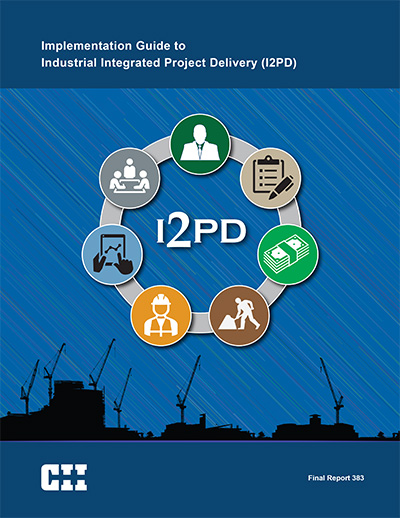
Implementation Guide to Industrial Integrated Project Delivery (I2PD)
During Phase I of CII’s exploration of Industrial Integrated Project Delivery (I2PD), Research Team 341 evaluated the potential of increasing integration and collaboration by applying the principles of Integrated Project Delivery (IPD) and Alliancing in the industrial capital projects sector. RT-341 created the I2PD framework by drawing upon the shared principles and methods of IPD and Alliancing that are suitable for the business environment and attributes of industrial projects.
During Phase II (this phase of the study), Research Team 383 focused on rapid and effective implementation and deployment of I2PD by developing the three main elements of this report (two Excel-based proof-of-concept tools and a detailed summary of methods):
- The selection of the most appropriate project delivery method is critical for a capital project to meet its intended goals and achieve project outcomes. The I2PD Project Selection Tool uses the core spectrum of project risks and complexities to support this important decision-making process during the early project development stage.
Chapter 2 provides comprehensive guidance for the owner to evaluate whether I2PD is the right project delivery method for a project under consideration.
- After selecting I2PD as the project delivery method, the next crucial decision to make is to choose the most suitable set of C.I. methods for the project. Limited resources and project constraints probably preclude the full implementation of all available methods; therefore, it is vital to prioritize and balance which methods to use to optimize the benefits of I2PD: ensuring the efficient information flow, risk management, and decision-making; focusing on achieving project-centered objectives.
The Collaboration and Integration (C.I.) Selection Tool can serve as an excellent resource to help a team evaluate its specific project characteristics and team members’ previous organizational experience to identify and select the most effective set of C.I. methods for the project. Chapter 3 offers guidance on how to apply the selection tool to prioritize which methods will best serve the project.
- This guidebook also provides implementation guidance on the 22 C.I methods for I2PD projects. Chapter 4 presents this guidance in the context of What, Who, Where, When, and How. This 5W1H approach gives project managers a comprehensive understanding of each method, enabling them to implement it with confidence in their projects.
RT-383 identified project uncertainty criteria – nine indicators for design, plus another 14 for execution – to assess a project’s suitability for I2PD. The team found that projects with high degrees of uncertainty in design and execution made the best candidates for I2PD (FR-383, p. 33).
RT-383 analyzed data from 69 industrial projects, identified how the projects applied CI methods, and used the results to prioritize the methods (FR-383, p. 25). As Figure 3 shows, the team sorted the CI methods into three tiers of relative applicability based on project characteristics and the organization’s level of experience:
- Tier 1 CI methods: the essential set of CI methods
- Tier 2 CI methods: a set of highly recommended CI methods
- Tier 3 CI methods: a set of other recommended CI methods
Figure 3. Criteria and Result of the I2PD Project Selection Tool
RT-383 also developed an Excel-based CI Methods Selection Tool (FR-383, p. 16). This tool applies a user’s selections to generate two validated indices (shown in Figure 2):
- The Uncertainty Index determines what level of collaboration and integration a project requires.
- The CI Index determines the appropriate frequency and intensity of applying CI methods that the tool selects for the project. If a project’s uncertainty index is high, the project team should adopt more CI methods to meet the required level of collaboration and integration.
Figure 2. CI Methods Selection Tool
RT-383 developed a comprehensive manual for each CI method so industrial practitioners can implement these methods with confidence (FR-383, p. 38). The CI implementation guidance adopted the 5W1H approach (e.g., what, who, where, when, why, and how) to provide rich context for each method (see Figure 4).
Figure 4. How the 5W1H Approach Organizes Implementation Guidance for CI Methods
RT-383 developed the I2PD Project Selection Tool, a decision-support instrument for assessing and measuring project uncertainty. Figure 1 shows how this Excel-based tool helps a team decide whether I2PD is suitable for its project (FR-383, p. 7).
Figure 1. Criteria and Result of the I2PD Project Selection Tool


